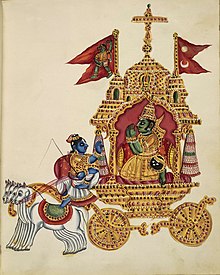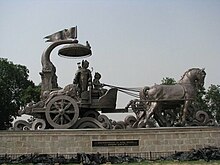Bhagavad Gita
From Wikipedia, the free encyclopedia
For other uses, see Bhagavad Gita (disambiguation).
"Gita" redirects here. For other uses, see Gita (disambiguation).
| Bhagavad Gita | |
|---|---|

Krishna and Arjuna at Kurukshetra, c. 1830 painting
| |
| Information | |
| Religion | Hinduism |
| Language | Sanskrit |
| Verses | 700 |
The Bhagavad Gita (Sanskrit: भगवद्गीता, bhagavad-gītā in IAST, Sanskrit pronunciation: [ˈbʱəɡəʋəd̪ ɡiːˈt̪aː]; lit. "Song of the Lord"[1]), often referred to as simply theGita, is a 700-verse Hindu scripture in Sanskrit that is part of the Hindu epic Mahabharata.
Hindu traditionalists assert that the Gita came into existence in the third or fourth millennium BCE. Scholars accept dates from the fifth century to the second century BCE as the probable range.
The Gita is set in a narrative framework of a dialogue between Pandava prince Arjuna and his guide and charioteer Lord Krishna. Facing the duty as a warrior to fight the Dharma Yudhha or righteous war between Pandavas and Kauravas, Arjuna is counselled by Lord Krishna to "fulfill his Kshatriya (warrior) duty as a warrior and establish Dharma."[2] Inserted[2] in this appeal to kshatriya dharma (chivalry)[3] is "a dialogue ... between diverging attitudes concerning methods toward the attainment of liberation (moksha)".[4] The Bhagavad Gita was exposed to the world through Sanjaya, who senses and cognizes all the events of the battlefield.[5] Sanjaya is Dhritarashtra's advisor and also his charioteer.
The Bhagavad Gita presents a synthesis[6][7] of the concept of Dharma,[6][7][8] theistic bhakti,[9][8] the yogic ideals[7] of moksha[7] through jnana, bhakti, karma, and Raja Yoga (spoken of in the 6th chapter)[10] and Samkhya philosophy.[web 1][note 1]
Numerous commentaries have been written on the Bhagavad Gita with widely differing views on the essentials. Vedanta commentators read varying relations between Self and Brahman in the text: Advaita Vedanta sees the non-dualism of Atman (soul) and Brahman as its essence,[11] whereas Bhedabheda andVishishtadvaita see Atman and Brahman as both different and non-different, and Dvaita sees them as different. The setting of the Gita in a battlefield has been interpreted as an allegory for the ethical and moral struggles of the human life.
The Bhagavad Gita's call for selfless action inspired many leaders of the Indian independence movement including Bal Gangadhar Tilak and Mohandas Karamchand Gandhi. Gandhi referred to the Gita as his "spiritual dictionary".[12]
| Part of a series on |
| Hindu scriptures and texts |
|---|
 |
| Related Hindu texts |








No comments:
Post a Comment